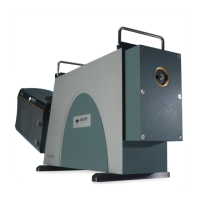46
Version 4.2 rev 06 Oct 2020
8.2 x 8.2 mm / 512 x 512 sensor
Lowest Noise Imaging EMCCD
Mechelle
4.9 standaRd laMps
Operating and maintaining black body sources is a difcult and skilled task and is usually only done by national
standards labs such as the National Institute of Standards and Technology (NIST) in the USA (formerly known as NBS). A
more practical calibration source is a CW incandescent tungsten lament lamp that has been calibrated against a black
body source. These lament lamps are known as primary working standard lamps; some are of particularly elaborate
design with special laments and stress-free envelopes, but all give good uniform illumination and are operated from
well regulated power units.
These primary working standards remain at NIST, but NIST will supply a secondary working standard and its power unit,
calibrated from the primary working standard, or they will calibrate a lamp and power unit supplied by you (National labs
in other countries offer similar services). Also there are some commercial companies selling these standard lamps.
The lamps are supplied with calibration data consisting of a printed list of Irradiance outputs at different wavelengths
at a specied distance from the lamp. These secondary standards are expensive and have short life times (about 200
hours). General purpose lament lamps, graded for good uniformity, are more commonly used as standards; these have
been calibrated against a secondary standard and give traceable accuracies of 5% to 10%.
Since the Mechelle has a very wide wavelength range, the standard lamp used must cover the same wavelength range
or more. Unfortunately these is no lamp can cover 200 nm - 975 nm, therefore two lamps are required to carry out this
procedure. Typically a deuterium lamp is used from 200 - 400 nm then a Quartz Tungsten Halogen (QTH) lamp is used
from 380 - 975 nm. Deuterium lamps are arc lamps lled with deuterium at low pressure. They produce high, spectrally
smooth, UV output with little visible and IR, this makes them ideal as UV spectral irradiance standards. For reasons we
will not go into here, accuracy and reproducibility in this wavelength range is about half that attainable in the visible range.
Figure 24: Spectral irradiance output of a deuterium standard lamp and QTH
Many commercial companies supply both QTH and deuterium standard lamps with regulated power units, and cover
the wavelength range of 200 nm - 1100 nm. Figure 24 above shows a typical output data from a commercially available
Deuterium-Tungsten lamp.
Before commencing relative intensity correction the following criteria must be met:
1. The standard calibration data relating to your particular standard lamps are saved in text les (*.txt) in specied
directory. These les will most likely have been supplied by your lamp vendor. Each line of the le contains a
wavelength (in nm) and an irradiance value (μW cm
-2
nm
-1
) separated by one or more spaces or tabs. If a le is not
supplied with your lamp, you may use a text editor to create one of your own from the lamp vendor’s data sheet.
NOTE: The two les must have at least 50 nm overlap.
2. Full-spectrum mode is selected
3. Accurate wavelength calibration is carried out
4. Select setup acquisition mode to either “single scan” or “Accumulate”
Refer to detector specication to nd the detector spectral range, e.g. iStar 18F-03 spectral range (180 - 850 nm).

